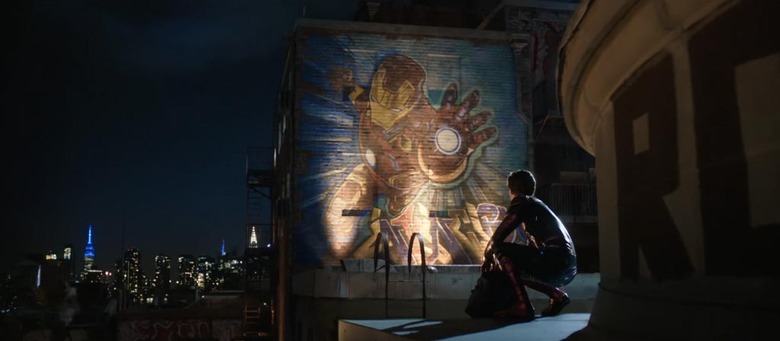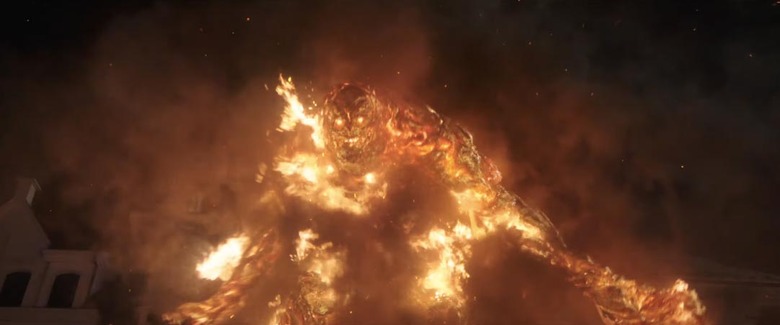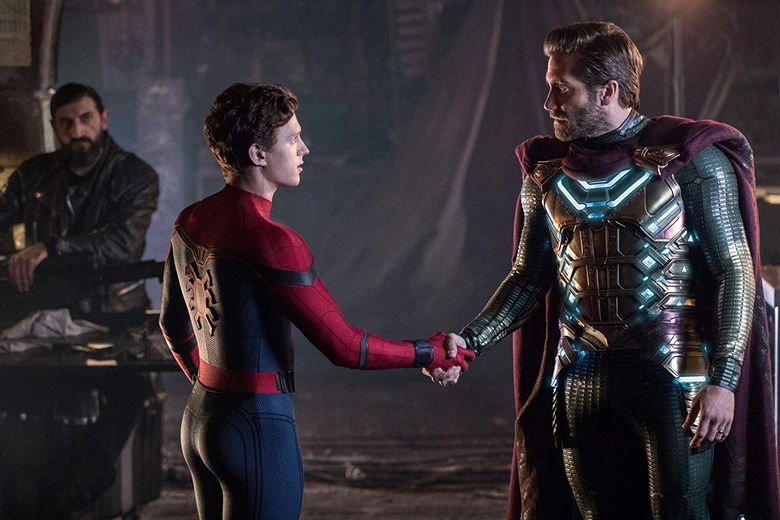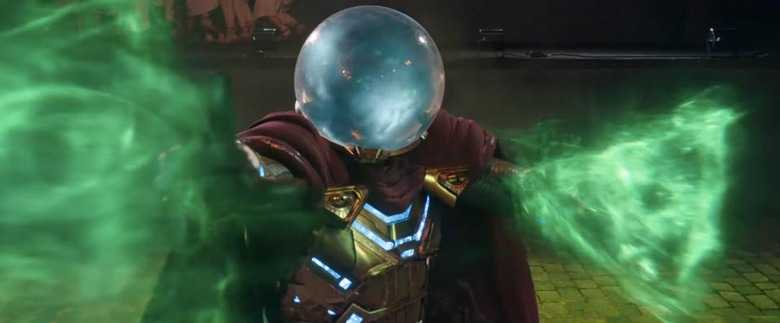'Spider-Man: Far From Home' Spoiler Review: With Great Power Comes A Villain Made For Our Troubled Times
In his novel White Noise, which won the National Book Award, Don DeLillo famously wrote of an "Airborne Toxic Event." It almost sounds like a plot device from a superhero blockbuster. Think: Suicide Squad's self-conscious recognition of the "swirling ring of trash in the sky" trope. The weakest part, visually, of Spider-Man: Far from Home — an otherwise super-enjoyable romp through the post-Endgame MCU — is its CG "Elementals." These were glimpsed in trailers so it's no big spoiler to say they're part of the movie or that one of them does internally swirl in a ring-like formation.
What's interesting about the Elementals is that they're loosely based on Marvel Comics villains yet their function in Far from Home, beyond the obvious spectacle, is largely symbolic. Full of sound and fury, signifying something, they're the superhero blockbuster equivalent of a tweetstorm. Cross-reference: DeLillo's Airborne Toxic Event. Notwithstanding the recent victory of Thanos, the Marvel Cinematic Universe has struggled in some ways to bring to life its supervillains with as much panache as its heroes. In this one respect, the intellectual-property farm of Marvel Comics has never quite enjoyed its full harvesting potential for Marvel Studios.
Not to worry: Tom Holland's Spider-Man is now batting 2-for-2, villain-wise, in his solo movie adventures. The media loves a good scene-chewing villain: can we agree on that? Rather than argue politics in a superhero movie review, let's objectively consider the idea of an attention-grabbing public figure who consistently "cuts through all the static" — vast, continental clouds of white noise — to make sensational headlines. Is he the anointed one, this man? Can he be trusted with ultimate power? To talk about that, we'll need to get busy with some spoilers for Spider-Man: Far from Home.
The MCU, Phase Three, Season Finale
It wasn't always clear why Phase Three of the MCU would be ending with Far from Home. The way Ant-Man was tacked onto the end of Phase Two made it seem like the delineation between phases was rather arbitrary. Now that Far from Home is in theaters, it's easy to see why Phase Three is wrapping up with this movie instead of the big climax of Avengers: Endgame.
In the same way that serialized television dramas like the recently ended Game of Thrones have often followed the model of letting the big stuff go down in the penultimate episode of the season, the MCU packed the penultimate film of Phase Three with the death of Iron Man and Black Widow and the expedited aging of Captain America. All three of these characters are memorialized at the beginning of Far From Home in a cutely awkward high school video set to the tune of Whitney Houston's "I Will Always Love You."
Holland's millennial version of Peter Parker would probably lump The Bodyguard, the 1993 film in which Houston's rendition of the song first appeared, together with The Empire Strikes Back as one of those "really old movies." This is especially true since, in case anyone's forgotten, it's 2023 now in the MCU. Five years passed between the Snap, when half the world turned to dust at the end of Infinity War, and the newly labeled "Blip," when half the world blinked back into existence in Endgame.
Some of Peter's high school classmates are shown blipping onto the basketball court in the middle of a game. Others have to face the fact that their younger siblings are now older than them. Conveniently, key supporting cast members such as Peter's best friend, Ned Leeds (Jacob Batalon), his love interest, MJ (Zendaya), Ned's own overnight plane girlfriend, Betty Brant (Angourie Rice), and even the rich bully, Flash Thompson (Tony Revolori) were all among the disappeared during the Snapture, so they haven't aged much since we last saw them in Spider-Man: Homecoming.
To be sure, Endgame left the next MCU film with a good deal of housekeeping to do. Far from Home handles the "Five years later ..." aspect with deft humor, like the moment when we see that Flash has been using the birth year on his old, pre-Snap I.D. to buy alcohol on the plane to Venice. He's 16, not 21.
As it turns out, Far from Home is very much one of those epilogue-like season finales that you see on premium TV channels. It's a coda to Endgame, one that deals with the aftermath of that film and the overarching Phase One to Phase Three Iron Man narrative, but in a personal way, as Peter grapples with Tony Stark's legacy on his own young life.
Tony is a big posthumous presence in this movie. Murals of him decorate the walls of buildings in New York, and on the plane to Venice, Peter's choice of inflight entertainment includes Heart of Iron: The Tony Stark Story. Before the closing credits roll, we'll also see a nightmare vision of Tony's zombified Iron Man suit come crawling up out of the grave to terrorize Peter during a hologram attack.
Yet over and above the Endgame epiloguing and Iron Man eulogizing, Far from Home also makes some unexpected callbacks to other MCU films. From a thematic standpoint, this is where things start to get really interesting ...
B.A.R.F.-Induced Holograms
Fools that we are, there are those of us who trusted Endgame co-director Joe Russo back in January 2018 when he seemingly debunked the idea of there being time travel in his upcoming mega-sequel (then known only as Avengers 4). To throw fans off the scent of some leaked set photos, Russo gave a fine bit of misdirection about the possible return of B.A.R.F., the Binarily Augmented Retro-Framing technology that showed us a baby-faced double of Robert Downey, Jr. in Captain America: Civil War.
At the time, Russo said that technology "was laid in for a very specific reason." He wasn't lying; he was just engaging in some smoke and mirrors, not unlike the real villain of Far from Home, the guy who controls the holographic Elementals.
As we all know, Endgame did feature time travel. Lo and behold, it's Far from Home that picks up the discarded plot point of B.A.R.F. and makes good use of it to show how some disgruntled ex-employees of Stark Industries (including one bald, bespectacled Arc Reactor scientist who we last saw Obadiah Stane haranguing all the way back in Iron Man) have formed a tech team around a very irresponsible, headline-chasing illusions specialist.
Going into this Fourth of July in the year of our Lord 2019, it's easy to see a famous egotistical shadow hovering in the background of Far from Home. It's not necessarily, at all times, the shadow of Tony Stark, either.
A few months ago, when revisiting Unbreakable — another superhero film co-starring Samuel L. Jackson, which was years ahead of its time — I wrote about how that film put forth the idea that comic books (and by extension, comic book movies) are a form of history. They absorb cultural patterns and even perhaps patterns in the collective unconscious that have yet to fully emerge in the culture at large.
In 1978, the prototypical comic book movie, Superman, introduced theatergoers to Lex Luthor, a big-city businessman with sketchy hair whose elaborate, nuke-inflected real estate schemes brought him into conflict with Clark Kent/Superman, a newspaper reporter and illegal alien (literally an extraterrestrial who rocketed to Kansas without a green card and lived there in hiding). Fast forward to 2000 and DC Comics would depict Lex Luthor running for President ... and winning. Our current real-life President had ended his first campaign prematurely that year, but now he's in the White House and the media and immigrants are his arch-enemies.
The point, which should be fairly obvious by now, is that comic books and comic book movies hold the secrets of the universe. One benefit of the MCU's serialized brand of big-screen storytelling is that it allows this fictional shared universe we're all watching to thread itself together more and more as it goes along. In the long run, viewers will have more of an appreciation for certain things once they see the full pattern, as it gradually takes shape over the course of multiple movies.
An unimpressed viewer might see the Elementals in Far from Home as barf-inducing CG constructs, bipedal puddles of molten goo, but in fact, they are holographic projections induced by a drone-based offshoot of the B.A.R.F. technology. When Spider-Man swings his way inside one, we see how the drones swirl in a ring to create a Whirlwind, city-attacking lie. They're an Airborne Toxic Event unleashed by the wanton Quentin Beck (Jake Gyllenhaal), who believes that "more casualties" equals "more coverage."
In his review of Far from Home, film critic David Ehlrich alluded to a villain "bellowing some half-baked Trumpian garbage about how easy it is to fool people who are already fooling themselves." I don't think Mysterio is half-baked. I think he's quite fully baked in a delicious way.
I would really need to sit down and think hard about who my favorite MCU villains are (there are enough good ones for at least a Top 5), but I can tell you right now that Mysterio would have an immediate ranking on whatever list I might draft up. This is not because of any affinity for what he represents; it's more because he, like Thanos, the living embodiment of death in the MCU, does have some subtextual meat on his bones and Gyllenhaal's performance sells it in such a gleefully entertaining way.
A Tech-Oriented Rogues Gallery
Anyone familiar with Spider-Man's rogues gallery could have probably guessed the twist that was coming in Far from Home, vis-a-vis Mysterio being a villain. Less predictable was the precise nature of his villainy.
Just last year, the Oscar-winning animated film, Spider-Man: Into the Spider-Verse introduced us to, well, the Spider-Verse; and just last month, director Jon Watts seemingly confirmed that Far from Home would be introducing the multiverse, as well. This came on the heels of Nick Fury feeding us lines in trailers about the Snap tearing a hole in our dimension.
The trailers set up Mysterio as a refugee from an outside dimension. Given everything we had just seen with the Quantum Realm and branching timelines in Endgame — plus external factors like Peter's five-movie MCU storyline and the box office success of Sony's Venom — it wasn't so outlandish to think that Mysterio might really be from an alternate reality, and moreover, that Peter Parker might wind up crossing over into that reality or some other like it in Far from Home.
Keep in mind, Sony's fledgling live-action Spider-Verse doesn't currently have a Spider-Man in it, just Venom. If there's going to be a Venom/Spider-Man crossover, they'll need to do some retconning or dimensional swapping.
In Far from Home, Mysterio's true nature winds up being much more grounded than that of some reality-hopping Elemental fighter. This is in keeping with the previous M.O. of the MCU's earthbound stories, which have been based more in science and technology. (Peter's school is actually named the Midtown School of Science and Technology.)
Even Thor took pains to have astrophysicist Jane Foster quote the Arthur C. Clarke rule, "Any sufficiently advanced technology is indistinguishable from magic." Doctor Strange, too, had the Ancient One liken magic spells to "a program, the source code that shapes reality."Far from Home does get trippy with its visuals in a manner reminiscent of Doctor Strange, but Spider-Man is a street-level hero and the villains of his that we saw in Homecoming were a bunch of blue-collar types led by the Vulture. They didn't gain superpowers through freak accidents, per comic book logic. Rather, they salvaged some alien Chitauri tech while doing cleanup after the Battle of New York.
Would an extra-dimensional Mysterio match the pseudo-realistic spirit of those guys? It may feature talking space raccoons who are email-savvy but outside the Avengers movies, the MCU follows a certain compartmentalization logic. This is the Spider-Man corner of the MCU, not Doctor Strange's Sanctum.
In a movie where Flash Thompson is a vlogger and we see him live-streaming videos from Europe to his "Flash Mob," it feels more appropriate to have the villain be someone who hijacks the media and uses it for his own nefarious, self-aggrandizing purposes. In a way, Mysterio is the Mandarin all over again, but instead of being a besotted pawn like Ben Kingsley's Trevor Slattery was in Iron Man 3, he's the one calling the shots on his manufactured image as a hero of ill-defined green energy powers.
He wears a fishbowl helmet and purple cape but his true form is that of a guy in a mo-cap suit who conjures illusions. "Unless you're flying around in a cape," he observes, "no one cares." Mysterio might as well be a stunt-driven YouTube personality trying to catch clicks in the sea of online distractions, where even dramatic international crises might plausibly be reduced to smartphone notifications (as seen in the recent Black Mirror episode, "Smithereens.")
With his attention-grabbing costume and staged acts of heroism, "everyone will listen" to Mysterio. He'll be able to fill the gap left by Iron Man on the world stage. Indeed, all the world's a stage to him.
Imagine what it would be like if a tweeter like Trump had drones with holographic projectors at his disposal instead of Twitter. Politics might then really become theater, as opposed to just a reality show writ large on the world itself. With "fake news" becoming such a big buzzword in recent years, it's germane that Far from Home manages to work in the George Orwell quote, "The very concept of objective truth is fading out of the world."
Man of Mysterio
Gyllenhaal's character in Velvet Buzzsaw taught me my new favorite word this year: ensorcel. Quentin Beck ensorcels Peter Parker by promising to be the bearded father figure Peter needs at this moment in his life, since Tony is no longer around. Quentin even lets Peter name him, as if to say, "Call me whatever you want. Your gullible perception of me is just an illusion, anyway."
In the movie, the Mysterio code name is one that arises by mistake when Peter and his classmates hear the phrase uomo di mistero ("man of mystery") on the news in Italy. The MCU skipped over showing Spider-Man's origin since that had already been done twice over with Tobey Maguire and Andrew Garfield, but Far from Home does feature a scene that is thematically similar to the one in Spider-Man's origin whereby he let a criminal escape and that same criminal ended up killing his Uncle Ben.
"With great power comes great responsibility." Those are the words that formed Spider-Man but in Far from Home, Peter learns this hard lesson in a very different way. He and Quentin, Spider-Man and Mysterio, have just defeated the last Elemental (before the climactic, super-duper combo-Elemental) and now they're saddling up at a pub in Prague. The movie has already shown us, by way of drone-filled misadventures on a European tour bus, how Peter has inherited this great responsibility from the late Tony Stark: a pair of glasses that wire him into a potentially dangerous artificial intelligence named EDITH (the acronym stands for, "Even Dead I'm The Hero," Tony's little joke from beyond the grave).
The problem is, Peter didn't think he was going to have to save the world this summer. He just wants to be a high schooler and hang out with his friends. Talking to Quentin, his eyes light up at the epiphany that he can hand the responsibility of EDITH off to someone else.
In doing so, he puts the A.I. in the wrong hands, entrusting it to a supervillain, who proceeds to give a gloating speech in the pub after Peter is gone and the holograms inside have broken up. With EDITH in his clutches, Quentin pumps up his team like an over-the-top Apple presenter pacing a dive bar countertop.
Mysterio has no compunctions about trying to kill Nick Fury or innocent civilians like Peter's friends, because again, more casualties spells more coverage. Any kind of collateral damage is fine with him as long as it fits his self-serving agenda as a media manipulator.
I'm no political expert but it seems to me, as a cinephile, that you could draw a direct line from the governship of Predator co-stars Arnold Schwarzenegger and Jesse Ventura to the surreal rise of Donald J. Trump as the leader of the free world. Since I'm currently overseas, writing this rather far from home myself, I'll leave it to the stateside reader to decide what, if any, subtle message Far from Home has to say about the responsibilities of the super-powerless (but not powerless) individual living in a post-truth society with celebrity politicians at the helm. The best superheroes are aspirational: they're what we wish we could be and should maybe strive to be like more often in terms of doing the right thing.
There are some big teases at the end of Far from Home for what's in store next in the MCU, including a mid-credits scene where Mysterio has the last laugh, weaponizing the media (as is his wont) against Spider-Man by revealing his secret identity to the world. J.K. Simmons shows up again as the bald MCU version of J. Jonah Jameson, but this time, it doesn't look like Peter Parker will be going to work for him at the Daily Bugle. It's also revealed in the final post-credits scene that the Nick Fury and Maria Hill we saw in this movie were Skrulls all along. Like Mysterio, they were not what they seemed. That's one last illusion reveal for the road, true believers.
There's more to dig into with Spider-Man: Far from Home. We'll have another article up this week looking at how the movie draws from comics history and what its ending teases might mean for the MCU going forward into Phase Four. In the meantime, remember: with great power comes great responsibility. Happy Fourth of July, America.




